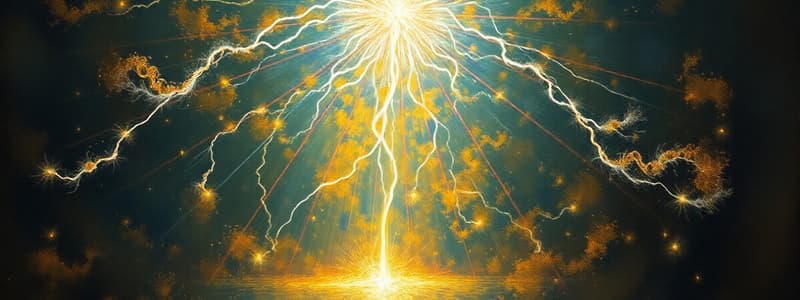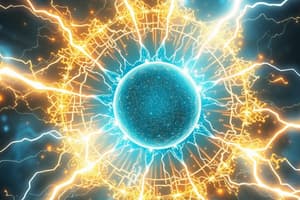Podcast
Questions and Answers
ما هو قياس قدرة المكثف على تخزين الشحنة الكهربائية؟
ما هو قياس قدرة المكثف على تخزين الشحنة الكهربائية؟
- المقاومة
- التردد
- الحساسية
- السعة (correct)
كيف يتم تخزين الطاقة الكهربائية في المكثفات؟
كيف يتم تخزين الطاقة الكهربائية في المكثفات؟
- بزيادة الجهد
- عن طريق تحويلها إلى حرارة
- بتراكم الشحنة على لوحاتها (correct)
- عن طريق تقليل السعة
ما الذي يحدث عندما يتغير المجال المغناطيسي؟
ما الذي يحدث عندما يتغير المجال المغناطيسي؟
- يحسّن من العزل الكهربائي
- يولد حرارة
- يؤدي إلى انقسام الذرات
- ينتج تيار كهربائي في موصل (correct)
أي من التطبيقات التالية يستخدم الحث الكهرومغناطيسي؟
أي من التطبيقات التالية يستخدم الحث الكهرومغناطيسي؟
ما هو الدور الذي تلعبه الكهرباء في التكنولوجيا الحديثة؟
ما هو الدور الذي تلعبه الكهرباء في التكنولوجيا الحديثة؟
ما هو الاستخدام الشائع للطاقة الكهربائية في مجالات النقل؟
ما هو الاستخدام الشائع للطاقة الكهربائية في مجالات النقل؟
ما هي التقنية الناشئة التي تعتمد على الكهرباء لابتكار مواد جديدة؟
ما هي التقنية الناشئة التي تعتمد على الكهرباء لابتكار مواد جديدة؟
ما الذي يهدف إليه تحسين مصادر الطاقة المتجددة؟
ما الذي يهدف إليه تحسين مصادر الطاقة المتجددة؟
ما هو ما تعنيه مستويات الطاقة بالنسبة للإلكترونات؟
ما هو ما تعنيه مستويات الطاقة بالنسبة للإلكترونات؟
ما هو تأثير الشحنات المماثلة على بعضها؟
ما هو تأثير الشحنات المماثلة على بعضها؟
كيف يمكن تعريف الطاقة الكهربائية المحتملة؟
كيف يمكن تعريف الطاقة الكهربائية المحتملة؟
ما هو ما يعبر عنه قانون أوم في الدوائر الكهربائية؟
ما هو ما يعبر عنه قانون أوم في الدوائر الكهربائية؟
كيف يُعرّف الجهد الكهربائي؟
كيف يُعرّف الجهد الكهربائي؟
ما الذي يحدد سلوك الإلكترونات في الذرة؟
ما الذي يحدد سلوك الإلكترونات في الذرة؟
أي من العبارات التالية صحيحة حول الشحنات المختلفة؟
أي من العبارات التالية صحيحة حول الشحنات المختلفة؟
ما هو التعريف الصحيح للتوصيلية؟
ما هو التعريف الصحيح للتوصيلية؟
Flashcards
الكهرباء
الكهرباء
قوة طبيعية تتعلق بتدفق الإلكترونات.
الذرة
الذرة
هي اللبنات الأساسية للمادة، تحتوي على نواة وإلكترونات.
الإلكترونات
الإلكترونات
جزيئات تحمل شحنة سالبة تدور حول النواة.
المستويات الطاقة
المستويات الطاقة
Signup and view all the flashcards
قانون كولوم
قانون كولوم
Signup and view all the flashcards
التيار الكهربائي
التيار الكهربائي
Signup and view all the flashcards
قانون أوم
قانون أوم
Signup and view all the flashcards
المقاومة
المقاومة
Signup and view all the flashcards
المكثف
المكثف
Signup and view all the flashcards
تخزين الشحنات
تخزين الشحنات
Signup and view all the flashcards
التحريض الكهرومغناطيسي
التحريض الكهرومغناطيسي
Signup and view all the flashcards
التيار المستحث
التيار المستحث
Signup and view all the flashcards
تطبيقات التحريض
تطبيقات التحريض
Signup and view all the flashcards
الطاقة المتجددة
الطاقة المتجددة
Signup and view all the flashcards
الحوسبة الكمومية
الحوسبة الكمومية
Signup and view all the flashcards
Study Notes
Electricity Fundamentals
- Electricity is a fundamental force of nature.
- It's the flow of electrons.
- Electrons are tiny particles with a negative charge.
- Electrons' movement powers our world.
Atomic Structure and Electrons
- Atoms are the building blocks of matter.
- Electrons orbit the nucleus (dense core).
- The nucleus contains protons and neutrons.
- Electrons' role: responsible for chemical bonds and electrical conductivity.
- Electron configuration: the arrangement of electrons in an atom determines its properties.
- Energy levels: electrons occupy specific energy levels that influence an atom's behavior.
- Quantum mechanics: electrons exhibit wave-particle duality, explained by quantum mechanics.
Electrical Charge and Coulomb's Law
- Electric charge is a fundamental property of matter.
- It exists as positive or negative.
- Like charges repel each other.
- Opposite charges attract each other.
- Coulomb's Law quantifies the force between two charged objects.
Electric Fields and Potential Energy
- A charged object creates an electric field, exerting forces on other charges.
- A charge within an electric field possesses potential energy.
- Work is done when a charge moves against the electric force.
- Potential difference between two points is called voltage, representing the difference in energy between them.
Electric Current and Resistance
- Electric current is the flow of electric charge (typically electrons).
- Electric current (I): the rate of flow of charge.
- Resistance (R): opposition to the flow of current.
- Conductivity: the ease with which electrons flow through a material.
Ohm's Law and Electrical Circuits
- Ohm's Law describes the relationship between current, voltage, and resistance in a circuit.
- Voltage: the driving force that pushes current through a circuit.
- Current: the flow of electric charge through a circuit.
- Resistance: the opposition to the flow of current in a circuit.
Capacitance and Capacitors
- Capacitance measures a capacitor's ability to store electric charge.
- Capacitor construction: two conductive plates separated by an insulating material.
- Charge storage: capacitors store electrical energy by accumulating charge on their plates.
- Applications: used in circuits for filtering, smoothing, and energy storage.
Electromagnetic Induction and Faraday's Law
- Electromagnetic induction: a changing magnetic field induces an electric current in a conductor.
- Magnetic field: a changing magnetic field is essential for induction.
- Conductor: a conductor is needed to carry the induced current.
- Induced current: the changing magnetic field induces an electric current.
- Applications: induction is used in generators, transformers, and other technologies.
Applications of Electricity in Technology
- Computers and electronics: Electricity powers the intricate circuitry of computers, smartphones, and numerous other devices.
- Transportation: Electric cars and trains offer a sustainable and efficient mode of transportation.
- Energy production: Renewable energy sources (wind and solar) rely on electricity generation.
Conclusion and Future Developments
- Nanotechnology: Exploring the use of electricity at the nanoscale for advanced materials and devices.
- Quantum computing: Developing new computational models based on the principles of quantum mechanics.
- Renewable energy: Improving renewable energy efficiency and accessibility through electricity-based solutions.
Studying That Suits You
Use AI to generate personalized quizzes and flashcards to suit your learning preferences.




